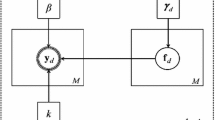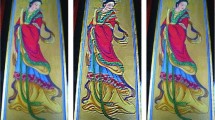Abstract
Blind motion deblurring is a highly challenging inverse problem in image processing and low-level computer vision. In this paper, we propose a novel approach to identify the parameters (blur length and orientation) of motion blur from an observed image. The kernel estimation is based on a novel criterion — the minimization of a blurred Stein’s unbiased risk estimate (blur-SURE): an unbiased estimate of a filtered mean squared error. By incorporating a simple Wiener filtering into the blur-SURE, the motion blur is estimated by minimizing this new objective functional with high accuracy. We then perform non-blind deconvolution using the high-quality SURE-LET algorithm with the estimated kernel. The results of synthetic and real experiments are quite competitive with other state-of-the-art algorithms under a wide range of degradation scenarios both numerically and visually.
Similar content being viewed by others
References
R. Fergus, B. Singh, A. Hertzmann, S. T. Roweis, and W. T. Freeman, “Removing camera shake from a single photograph,” ACM Trans. Graphics 25 (3), 787–794 (2006).
Q. Shan, J. Jia, and A. Agarwala, “High-quality motion deblurring from a single image,” ACM Trans. Graphics 27 (3), Article No. 73 (2008).
A. Levin, Y. Weiss, F. Durand, and W. T. Freeman, “Understanding and evaluating blind deconvolution algorithms,” in Proc. 2009 IEEE Conf. on Computer Vision and Pattern Recognition (Miami, FL, USA, 2009), pp. 1964–1971.
D. Kundur and D. Hatzinakos, “Blind image deconvolution,” IEEE Signal Process. Mag. 13 (3), 43–64 (1996).
R. Molina, J. Núñez, F. J. Cortijo, and J. Mateos, “Image restoration in astronomy: a Bayesian perspective,” IEEE Signal Process. Mag. 18 (2), 11–29 (2001).
A. S. Carasso, “Linear and nonlinear image deblurring: A documented study,” SIAM J. Numer. Anal. 36 (6), 1659–1689 (1999).
T. E. Bishop, S. D. Babacan, B. Amizic, A. K. Katsaggelos, T. Chan, and R. Molina, “Blind image deconvolution: Problem formulation and existing approaches,” in Blind Image Deconvolution: Theory and Applications, Ed. by P. Campisi and K. Egiazarian (CRC Press, Boca Raton, 2007), Chapter 1, pp. 1–42.
B. Amizic, R. Molina, and A. K. Katsaggelos, “Sparse Bayesian blind image deconvolution with parameter estimation,” EURASIP J. Image Video Process. 2012 (20), 15 pages (2012).
L. Yuan, J. Sun, L. Quan, and H.-Y. Shum, “Image deblurring with blurred/noisy image pairs,” ACM Trans. Graphics 26 (3), Article No. 1 (2007).
O. Whyte, J. Sivic, A. Zisserman, and J. Ponce, “Non-uniform deblurring for shaken images,” in Proc. 2010 IEEE Computer Society Conf. on Computer Vision and Pattern Recognition (San Francisco, CA, USA, 2010), pp. 491–498.
S. Cho and S. Lee, “Fast motion deblurring,” ACM Trans. Graphics 28 (5), Article No. 145 (2009).
A. Levin, Y. Weiss, F. Durand, and W. T. Freeman, “Efficient marginal likelihood optimization in blind deconvolution,” in Proc. IEEE Conf. on Computer Vision and Pattern Recognition (CVPR 2011) (Colorado Springs, CO, USA, 2011), pp. 2657–2664.
N. Joshi, R. Szeliski, and D. J. Kriegman, “PSF estimation using sharp edge prediction,” in Proc. 2008 IEEE Conf. on Computer Vision and Pattern Recognition (CVPR 2008) (Anchorage, AK, USA, 2008), pp. 1–8.
M. Hirsch, C. J. Schuler, S. Harmeling, and B. Schölkopf, “Fast removal of non-uniform camera shake,” in Proc. 2011 IEEE Int. Conf. on Computer Vision (ICCV2011x) (Barcelona, Spain, 2011), pp. 463–470.
J. Gast, A. Sellent, and S. Roth, “Parametric object motion from blur,” in Proc. 2016 29th IEEE Conf. on Computer Vision and Pattern Recognition (CVPR 2016) (Las Vegas, NV, USA, 2016), pp. 1846–1854.
J. Pan, R. Liu, Z. Su, and G. Liu, “Motion blur kernel estimation via salient edges and low rank prior,” in Proc. 2014 IEEE Int. Conf. on Multimedia and Expo (ICME) (Chengdu, China, 2014), pp. 1–6.
D. Krishnan and R. Fergus, “Fast image deconvolution using hyper-Laplacian priors,” in Advances in Neural Information Processing Systems 22: Proc. Annual Conf. NIPS 2009 (Vancouver, Canada, 2015), pp. 1033–1041.
T. F. Chan and C.-K. Wong, “Total variation blind deconvolution,” IEEE Trans. Image Process. 7 (3), 370–375 (1998).
B. Amizic, S. D. Babacan, R. Molina, and A. K. Katsaggelos, “Sparse Bayesian blind image deconvolution with parameter estimation,” in Proc. 2010 18th European Signal Processing Conf. (Aalborg, Denmark, 2010), pp. 626–630.
F. Krahmer, Y. Lin, B. McAdoo, K. Ott, J. Wang, D. Widemann, and B. Wohlberg, “Blind image deconvolution: Motion blur estimation,” Technical Report, IMA Preprint Series # 2133-5 (Institute for Mathematics and its Applications, University of Minnesota, 2006).
J. P. Oliveira, M. A. T. Figueiredom, and J. M. Bioucas-Dias, “Parametric blur estimation for blind restoration of natural images: Linear motion and out-of-focus,” IEEE Trans. Image Process. 23 (1), 466–477 (2014).
M. Ebrahimi Moghaddam and M. Jamzad, “Motion blur identification in noisy images using mathematical models and statistical measures,” Pattern Recogn. 40 (7), 1946–1957 (2007).
J. P. Oliveira, M. A. T. Figueiredo, and J. M. Bioucas-Dias, “Blind estimation of motion blur parameters for image deconvolution,” in Pattern Recognition and Image Analysis, IbPRIA 2007, Ed. by J. Marti, J. M. Benedi, A. M. Mendonça, and J. Serrat, Lecture Notes in Computer Science (Springer, Berlin, Heidelberg, 2007), Vol. 4478, pp. 604–611.
W. T. Freeman and E. H. Adelson, “The design and use of steerable filters,” IEEE Trans. Pattern Anal. Mach. Intell. 13 (9), 891–906 (1991).
J. Biemond, R. L. Lagendijk, and R. M. Mersereau, “Iterative methods for image deblurring,” Proc. IEEE 78 (5), 856–883 (1990).
H. Ji and C. Liu, “Motion blur identification from image gradients,” in Proc. 2008 IEEE Conf. on Computer Vision and Pattern Recognition (CVPR 2008) (Anchorage, AK, USA, 2008), pp. 1–8.
H. Sun, M. Desvignes, and Y. Yunhui, “Motion blur adaptive identification from natural image model,” in Proc. 2009 16th IEEE Int. Conf. on Image Processing (ICIP 2009) (Cairo, Egypt, 2009), pp. 137–140.
H. Sun, M. Desvignes, Y. Yan, and W. Liu, “Motion blur parameters identification from Radon transform image gradients,” in Proc. 2009 35th Annual Conf. of IEEE Industrial Electronics (IECON 2009) (Porto, Portugal, 2009), pp. 2098–2103.
S. Dai and Y. Wu, “Motion from blur,” in Proc. 2008 IEEE Conf. on Computer Vision and Pattern Recognition (CVPR 2008) (Anchorage, AK, USA 2008), pp. 1–8.
S. J. Reeves and R. M. Mersereau, “Blur identification by the method of generalized cross-validation,” IEEE Trans. Image Process. 1 (3), 301–311 (1992).
Y. Yitzhaky, I. Mor, A. Lantzman, and N. S. Kopeika, “Direct method for restoration of motion-blurred images,” J. Opt. Soc. Am. A. 15 (6), 1512–1519 (1998).
A. Levin, “Blind motion deblurring using image statistics,” Advances in Neural Information Processing Systems 19: Proc. Annual Conf. NIPS 2006 (Vancouver, Canada, 2006), pp. 841–848.
C. M. Stein, “Estimation of the mean of a multivariate normal distribution,” Ann. Stat. 9 (6) 1135–1151 (1981).
T. Blu and F. Luisier, “The SURE-LET approach to image denoising,” IEEE Trans. Image Process. 16 (11), 2778–2786 (2007).
Y. C. Eldar, “Generalized SURE for exponential families: Applications to regularization,” IEEE Trans. Signal Process. 57 (2), 471–481 (2009).
J.-C. Pesquet, A. Benazza-Benyahia, and C. Chaux, “A SURE approach for digital signal/image deconvolution problems,” IEEE Trans. Signal Process. 57 (12), 4616–4632 (2009).
C. Vonesch, S. Ramani, and M. Unser, “Recursive risk estimation for non-linear image deconvolution with a wavelet-domain sparsity constraint,” in Proc. 2008 15th IEEE Int. Conf. on Image Processing (ICIP 2008) (San Diego, CA, USA, 2008), pp. 665–668.
R. Giryes, M. Elad, and Y. C. Eldar, “The projected GSURE for automatic parameter tuning in iterative shrinkage methods,” Appl. Comput. Harmonic Anal. 30 (3), 407–422 (2011).
F. Xue, F. Luisier, and T. Blu, “SURE-LET image deconvolution using multiple Wiener filters,” in Proc. 2012 19th IEEE Int. Conf. on Image Processing (ICIP 2012) (Orlando, FL, USA, 2012), pp. 3037–3040.
F. Xue, F. Luisier, and T. Blu, “Multi-Wiener SURE-LET deconvolution,” IEEE Trans. Image Process. 22 (5), 1954–1968 (2013).
F. Xue and T. Blu, “SURE-based blind Gaussian deconvolution,” in Proc. 2012 IEEE Statistical Signal Processing Workshop (SSP) (Ann Arbor, MI, USA), pp. 452–455.
F. Xue and T. Blu, “A novel SURE-based criterion for parametric PSF estimation,” IEEE Trans. Image Process. 24 (2), 595–607 (2015).
F. Xue, J. Liu, S. Jiao, S. Liu, M. Zhao, Z. Niu, “SURE-type functionals as criteria for parametric PSF estimation,” J. Math. Imaging Vis. 54 (1), 78–105 (2016).
N. Wiener, Extrapolation, Interpolation, and Smoothing of Stationary Time Series, With Engineering Applications (Wiley, New York, 1964).
O. Michailovich and A. Tannenbaum, “Blind deconvolution of medical ultrasound images: A parametric inverse filtering approach,” IEEE Trans. Image Process. 16 (12), 3005–3019 (2007).
T. S. Cho, S. Paris, B. K. P. Horn, and W. T. Freeman, “Blur kernel estimation using the radon transform,” in Proc. IEEE Conf. on Computer Vision and Pattern Recognition (CVPR 2011) (Colorado Springs, CO, USA, 2011), pp. 241–248.
S. Cho and S. Lee, “Fast motion deblurring,” ACM Trans. Graphics (SIGGRAPH Asia 2009) 28 (5), article no. 145 (2009).
L. Xu, J. Jia, “Two-phase kernel estimation for robust motion deblurring,” in Computer Vision — ECCV2010, Proc. 11th European Conf. on Computer Vision, Part I, Ed. by K. Daniilidis, P. Maragos, and N. Paragios, Lecture Notes in Computer Science (Springer, Berlin, Heidelberg, 2010), Vol. 6311, pp. 157–170.
P. Pankajakshan, L. Blanc-Féraud, B. Zhang, Z. Kam, J. Olivo-Marin, and J. Zerubia, “Parametric blind deconvolution for confocal laser scanning microscopy (CLSM)-proof of concept,” Research Report RR-6493 (INRIA, 2008). https://hal.inria.fr/inria-00269265
Author information
Authors and Affiliations
Corresponding author
Additional information
The article is published in the original.
Jing Li was born in Hebei, China, in 1986. She received her Bachelor degree from School of Foreign Languages, Peking University, in 2011; Master degree in Translation and Interpretation in Public Services from Faculty of Humanities, Universidad de Alcalá, in 2012, and PhD in Humanities from Universidad Carlos III de Madrid, in 2015. She is currently with School of Foreign Languages, Renmin University of China, Beijing, China. Her main research interests include computational linguistics, corpus-based analysis, data processing and analysis.
Rights and permissions
About this article
Cite this article
Li, J. A Blur-SURE-Based Approach to Kernel Estimation for Motion Deblurring. Pattern Recognit. Image Anal. 29, 240–251 (2019). https://doi.org/10.1134/S1054661819010164
Received:
Revised:
Accepted:
Published:
Issue Date:
DOI: https://doi.org/10.1134/S1054661819010164




